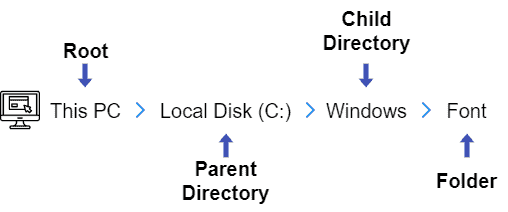1. 概述
在管理数字文件时,我们常常会纠结:到底该用“目录”还是“文件夹”?虽然两者都能用来组织文件,但它们在技术层面的定位和用途其实存在显著差异。
本文将从技术角度出发,解析目录与文件夹的核心区别,并帮助你在实际使用中做出更合适的选择。
2. 目录简介
目录(Directory)是文件系统中用于组织和管理文件的结构单位,可以看作是“虚拟文件柜”。与文件夹不同的是,目录不仅可以包含文件,还可以包含子目录,从而形成一个树状的层级结构。
目录是操作系统中文件系统的基础组成部分,常见于 MS Windows、Unix 和 Linux 等系统中。它不仅可以存放文件,还能引用其他目录,形成嵌套结构。
例如,我们在电脑上创建了一个名为 Font 的文件夹:

在这个结构中:
This PC是根目录(root)Local Disk (C)是父目录(parent directory)Windows是子目录(child directory)
操作系统通常会提供一些默认目录,如 Documents、Pictures、Music 等,用户也可以根据需要自定义创建新目录。
3. 文件夹简介
文件夹(Folder)是操作系统提供给用户的一个图形化界面概念,它本质上是对目录的封装。文件夹只能存放文件,不能存放其他文件夹(虽然看起来可以,但其实是目录结构在支撑)。
文件夹的作用是帮助用户更直观地管理文件,比如创建、移动、重命名、删除等操作。你可以将文档、图片、视频等文件拖拽到文件夹中,也可以在文件夹下创建子文件夹。
需要注意的是:
✅ 文件夹本身不占用磁盘空间
❌ 某些字符不能用于命名文件夹,如:\/:*?"<>|
⚠️ 文件夹在操作系统中是“虚拟容器”,实际结构仍由目录支撑
4. 核心区别对比
以下是从多个维度对比目录和文件夹的差异:
| 特性 | 目录 | 文件夹 |
|---|---|---|
| 存储内容 | 可以包含文件和其他目录 | 只能包含文件(视觉上可以包含子文件夹) |
| 占用空间 | 是,通常占用约 4KB | 否,不占用磁盘空间 |
| 层级结构 | 多级嵌套结构 | 单层结构(视觉上是嵌套) |
| 适用场景 | 适合组织大量、结构复杂的数据 | 适合组织少量、结构简单的数据 |
| 操作能力 | 支持创建、删除、打开、关闭、读取、重命名、链接、取消链接等 | 支持创建、共享、重命名、移动、删除 |
| 可访问性 | 提供更灵活的访问路径 | 提供基础访问能力 |
5. 如何选择?
从 OS 开发者角度来看,目录是实现文件系统组织的核心结构;而文件夹是面向用户的图形化抽象。因此:
✅ 如果你面对的是大量数据、需要多层级结构来管理,应优先使用目录
✅ 如果只是简单的文件归类,使用文件夹即可,操作更直观
从用户角度来说:
- Windows / Linux 系统用户通常直接操作的是文件夹,但底层仍依赖目录结构
- 若你希望构建更复杂的文件管理体系,理解目录机制是必要的
⚠️ 文件夹只是目录的“前端展示”,真正起作用的是目录结构本身
6. 总结
目录与文件夹虽常被混用,但它们在技术上有本质区别:
- 目录是操作系统层面的组织结构,支持多级嵌套
- 文件夹是用户界面中的可视化抽象,用于简化操作
理解这些区别,有助于你在日常工作中更高效地管理文件,也能在系统设计或脚本开发中避免踩坑。